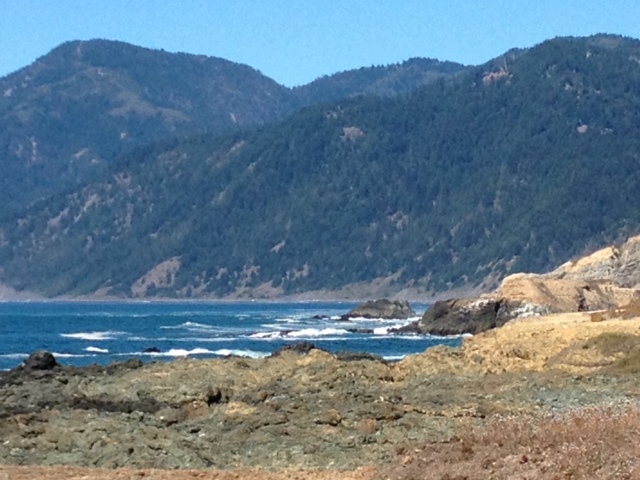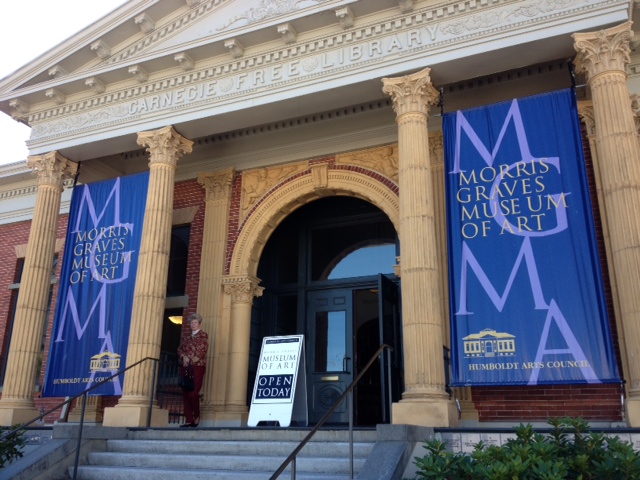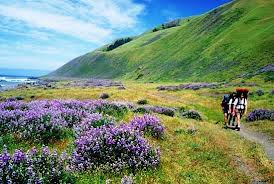
It’s been called the finest forest drive in the world, a 32-mile stretch of road that winds through 17,000 acres of old-growth redwood forest.
The Avenue of the Giants is the primary reason people from all over the globe visit California’s Humboldt County. After experiencing the route yesterday, I can easily say that you should put it on your travel wish list, without hesitation! As soon as you veer off Highway 101 onto Avenue of the Giants (Exit 674 from the north) and stop to pick up a map, get out of the car and lost on a trail surrounded by these gargantuan patriarchs of the forest. Covered in shaggy bark with trunks the size of a Dodge Ram, you look up and it’s impossible to see the tops of these trees piercing the blue skies. At the next stop, the Drury-Chaney Grove, my brother, Jim, and I climbed atop a fallen redwood, some 15 feet above the ground, and walked a good 50 meters on that same tree. Mind-blowing. It’s hard not to feel Lilliputian dwarfed by these mega-sized giants rising from a carpet of ferns. The tall redwoods hug the road, allowing only a splinter of sunlight into the dark forest as you drive along the route. In Myers Flat, you get to take that iconic shot of driving a car through the roots of a redwood at the Drive-Thru Tree. With an opening only 7-foot wide, it was ideally suited for our Toyota Corolla rental, inches to spare on either side.
Ten miles south of the southern end of the Avenue of the Giants, right off Highway 101, is one of California’s classic retreats, the
Benbow Inn. Open in the summer of 1926, the Tudor estate on the shores of the Eel River soon attracted such Hollywood elite as Clark Gable and Joan Fontaine, and other luminaries like Eleanor Roosevelt and Herbert Hoover. Today, it’s still the premier address in the region, ideally suited for folks who made the 4-hour drive from San Francisco. Ask for Room 109 and you’ll get a private patio with two redwoods sprouting up from the deck, and a view of the arched stone bridge, built in 1932. Owner John Porter is a wine aficionado, so expect your dinner of nearby Shelter Cove salmon or locally sourced rack of lamb to be washed down with some of the finest wines coming out of Napa, Sonoma, even Humboldt County.
 Six miles south of Benbow, in Leggett, California, Pacific Coast Highway or Hwy 1 comes to an abrupt end. Highway 101 will pick up the slack and hug the shoreline north of Arcata on a picturesque drive of headlands rising from the Pacific as you drive to Orick. But that still leaves 80 miles of wilderness shoreline, not easily accessible from any highway. Called the Lost Coast, it is the longest undeveloped coastline in the continental United States. Yesterday, we took the twisting and turning Bryceland-Thorn Road from Redway to the remote village of Shelter Cove. At this small coastal community, houses hug the shoreline backed by flanks of forest and high headlands that make up the King Range National Conservation Area. Backpackers can take the rugged 25-mile Lost Coast Trail, while day-trippers should head to the crescent-shaped black sand beach. Fishing trawlers were docked in the bay, also popular with stand-up paddleboarders and several surfers. If you want to leave behind the woes of modernity and de-stress on a serene stretch of Californian coast, consider spending some time at the Inn of the Lost Coast.
Six miles south of Benbow, in Leggett, California, Pacific Coast Highway or Hwy 1 comes to an abrupt end. Highway 101 will pick up the slack and hug the shoreline north of Arcata on a picturesque drive of headlands rising from the Pacific as you drive to Orick. But that still leaves 80 miles of wilderness shoreline, not easily accessible from any highway. Called the Lost Coast, it is the longest undeveloped coastline in the continental United States. Yesterday, we took the twisting and turning Bryceland-Thorn Road from Redway to the remote village of Shelter Cove. At this small coastal community, houses hug the shoreline backed by flanks of forest and high headlands that make up the King Range National Conservation Area. Backpackers can take the rugged 25-mile Lost Coast Trail, while day-trippers should head to the crescent-shaped black sand beach. Fishing trawlers were docked in the bay, also popular with stand-up paddleboarders and several surfers. If you want to leave behind the woes of modernity and de-stress on a serene stretch of Californian coast, consider spending some time at the Inn of the Lost Coast. 
 It’s been called the finest forest drive in the world, a 32-mile stretch of road that winds through 17,000 acres of old-growth redwood forest.
It’s been called the finest forest drive in the world, a 32-mile stretch of road that winds through 17,000 acres of old-growth redwood forest.  They say Eureka has more artists per capita than any other place in California. A walk around town Sunday introduced me to many of the impressive local wares. My first stop was the
They say Eureka has more artists per capita than any other place in California. A walk around town Sunday introduced me to many of the impressive local wares. My first stop was the  Five hours north of San Francisco on Hwy 101, you reach Humboldt County, otherwise known as
Five hours north of San Francisco on Hwy 101, you reach Humboldt County, otherwise known as